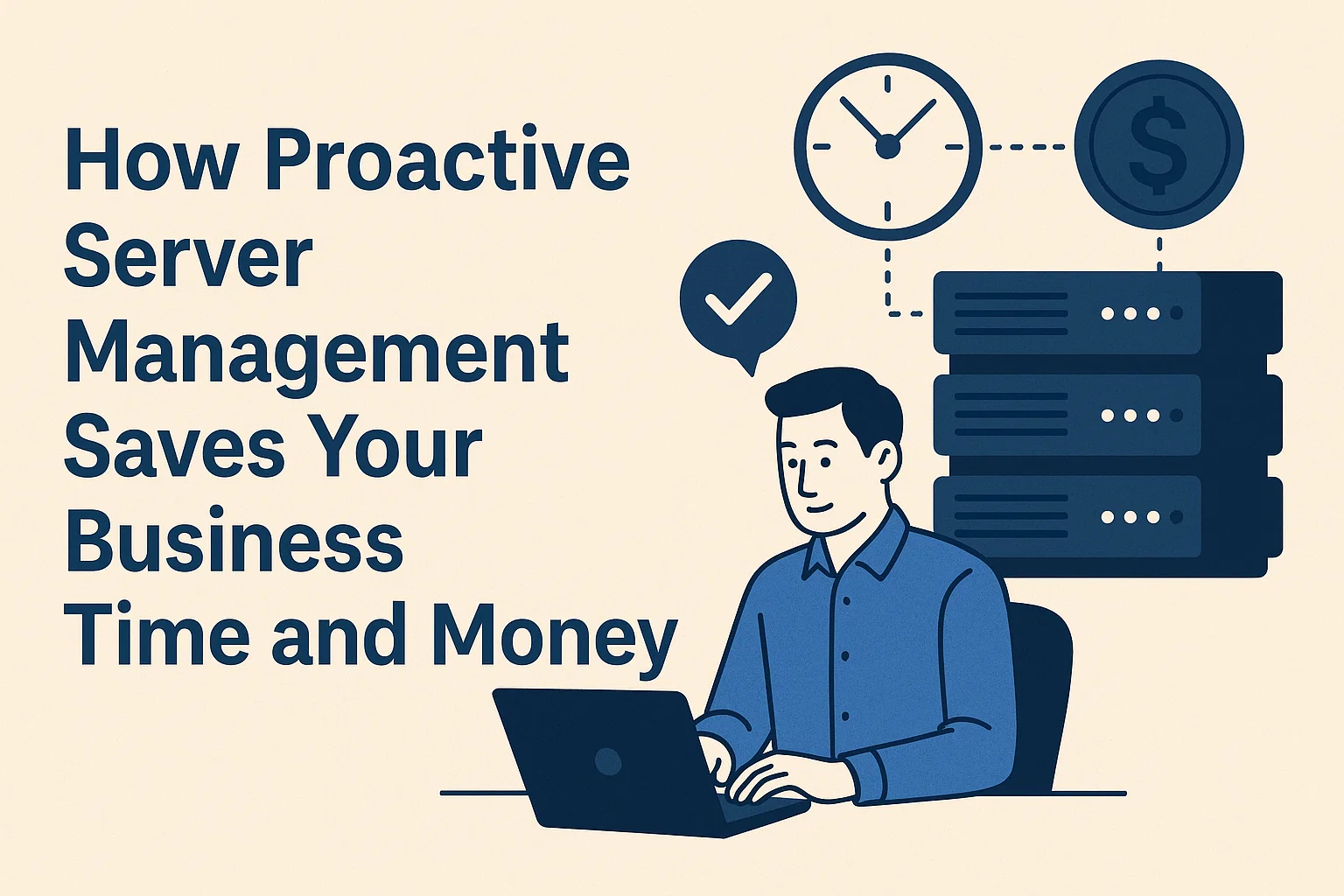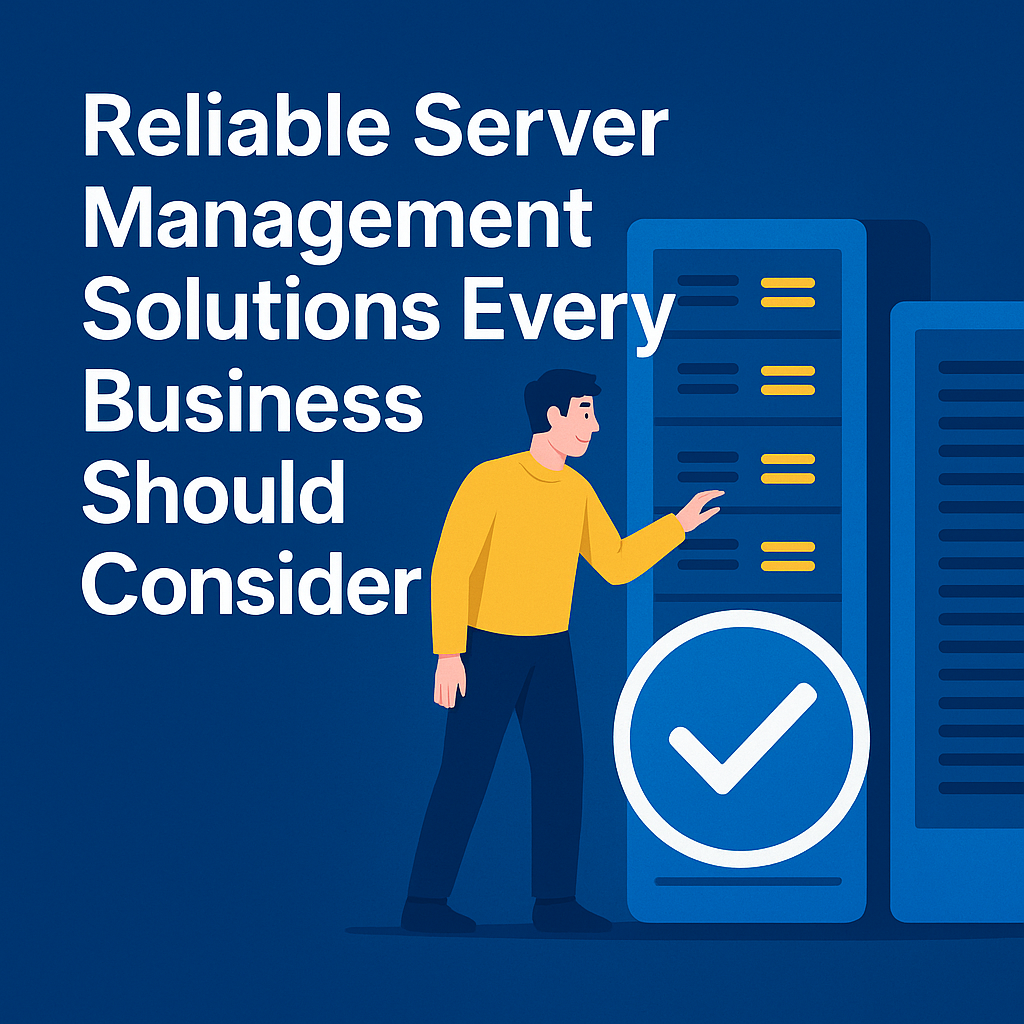How Proactive Server Management Saves Your Business Time and Money

Every business owner dreads that moment: the server crashes at the worst possible time, customers can’t access your services, and your team scrambles to fix problems that seemingly appeared from nowhere. What most don’t realize is that these “sudden” failures rarely happen without warning. They’re the result of neglecting what could have been caught early through proactive server management.
The True Cost of Reactive IT
When businesses operate with a “fix it when it breaks” mentality, they’re setting themselves up for expensive surprises. Reactive management means dealing with server issues only after they’ve already impacted operations. A single hour of downtime can cost small to medium businesses thousands of dollars in lost revenue, damaged reputation, and decreased productivity.
Beyond the immediate financial hit, there’s the hidden drain on resources. Your IT team drops everything to fight fires instead of working on strategic initiatives.Staff are left unable to work as they wait for systems to be restored and operational again.
Customer trust erodes with each outage. These ripple effects compound over time, creating a cycle of inefficiency that holds your entire organization back.
What Proactive Server Management Actually Means
Proactive server management shifts the paradigm from reactive crisis response to preventive care.This approach includes ongoing monitoring, routine upkeep, performance tuning, and forward-looking planning to stop issues from growing into major disruptions.
This approach includes automated monitoring systems that track server health metrics around the clock, catching anomalies before they become critical failures. Regular security patches get applied systematically rather than hastily after a breach. Storage capacity is expanded before you run out of space, not after operations grind to a halt.
The difference is like maintaining your car with regular oil changes versus waiting for the engine to seize. One approach extends the life of your investment and prevents breakdowns; the other guarantees expensive repairs and inconvenient failures.
Time Savings That Compound Daily
Proactive management creates efficiencies that multiply across your organization. When servers run optimally, applications load faster, databases respond quickly, and employees work without frustrating delays. Those seconds saved per task become hours saved per week, especially across dozens or hundreds of employees.
Your IT team benefits even more dramatically. Instead of living in constant firefighting mode, they can focus on improvements that drive business value. They can focus on rolling out new features, improving processes, and driving growth initiatives instead of wasting time fixing problems that could have been prevented.
The psychological benefit shouldn’t be underestimated either. When your team isn’t constantly stressed about potential outages, morale improves, turnover decreases, and productivity rises. People do their best work when they’re not perpetually anxious about technical disasters.
The Financial Case for Prevention
The math behind proactive server management is compelling. Studies consistently show that preventing an issue costs a fraction of fixing it after failure. A proactive approach might identify a failing hard drive through SMART monitoring and replace it during scheduled maintenance. The reactive approach means discovering that failure when the drive crashes, potentially losing data and facing hours of emergency recovery work.
Consider the cost breakdown: proactive monitoring tools might run a few hundred dollars monthly, while a single major outage could cost tens of thousands in lost sales, recovery services, and overtime. The insurance policy aspect alone justifies the investment.
Proactive management also extends hardware lifespan. Servers that are properly maintained, kept cool, and run at appropriate capacity levels last years longer than neglected ones. This defers major capital expenses and improves your return on technology investments.
Security: Your Silent Money Drain
Cybersecurity breaches represent one of the most expensive consequences of reactive management. A proactive security approach includes regular vulnerability assessments, timely patching, intrusion detection, and security hardening. These measures stop attacks before they penetrate your defenses.
The reactive alternative is dealing with breaches after they occur, which brings catastrophic costs: forensic investigations, legal fees, regulatory fines, customer notification expenses, and potentially crippling reputational damage. For many small businesses, a significant breach is literally a company-ending event.
Beyond direct breach costs, there’s the ongoing expense of weak security. Malware that goes undetected for months can steal bandwidth, compromise customer data, and degrade performance. These silent drains on resources often go unnoticed in reactive environments but get caught immediately with proactive monitoring.
Scalability Without Growing Pains
Businesses that grow successfully need infrastructure that scales smoothly. Proactive management means planning for growth before you hit capacity limits. You analyze trends, forecast needs, and implement upgrades during convenient windows rather than emergency situations.
This forward-thinking approach prevents those awkward moments where business success creates technical failure. Your marketing campaign succeeds beyond expectations, but your servers can’t handle the traffic surge. Or you land a major client, but onboarding them overwhelms your systems. These growth penalties are entirely avoidable with proper planning.
Reactive businesses face the opposite problem: they overbuild out of fear, wasting money on excess capacity they don’t need. Proactive management right-sizes infrastructure based on actual data and realistic projections, optimizing your technology spend.
The Competitive Advantage
In markets where competitors struggle with reliability issues, your consistently available services become a significant differentiator. Customers notice when your website never goes down, your applications always respond quickly, and your services maintain steady performance.
This reliability builds trust that converts to customer loyalty and positive word-of-mouth. In contrast, competitors dealing with frequent outages train customers to see their unreliability as normal, eventually driving those customers to more dependable alternatives.
The internal competitive advantage matters too. Your team can move faster on new initiatives because they’re not constantly dealing with infrastructure problems. You can promise aggressive timelines and actually deliver because your technical foundation is solid.
Making the Transition
Moving from reactive to proactive management doesn’t require a complete overnight overhaul. Start by implementing basic monitoring to gain visibility into your server environment. Establish a regular maintenance schedule for updates and backups. Document your infrastructure so knowledge isn’t trapped in one person’s head.
As you build momentum, add more sophisticated elements: automated alerting, performance baseline analysis, capacity planning processes, and disaster recovery testing. Each improvement compounds the benefits of previous ones.
The investment pays for itself quickly. Most businesses see positive returns within the first few months as they avoid what would have been their next major outage or security incident.
The Bottom Line
Cloud environments gain even greater advantages from proactive management, as expenses can escalate rapidly without continuous oversight, and simple configuration mistakes can create serious security risks for your data.
Every business faces a choice: pay a little now for prevention or pay a lot later for crisis recovery. The businesses that thrive are the ones that recognize this isn’t really a choice at all. Proactive management is simply the smarter way to operate, protecting both your bottom line and your peace of mind while positioning your organization for sustainable success.
Frequently Asked Questions
How much does proactive server management typically cost?
The cost varies based on your infrastructure size and complexity, but most small to medium businesses invest between $500 to $3,000 monthly for comprehensive proactive management. This includes monitoring tools, maintenance services, and support. Compare this to the average cost of a single major outage, which typically ranges from $5,000 to $50,000 per incident, and the value becomes clear. Many businesses find that avoiding just one or two incidents per year more than justifies the entire annual investment.
Can’t our in-house IT team handle this without additional tools or services?
While talented IT teams can certainly implement proactive practices, they often lack the time and specialized tools to do so effectively while managing daily operations. Proactive management requires 24/7 monitoring, specialized expertise across multiple domains, and dedicated focus that’s difficult to maintain when handling routine support requests. Many businesses find that combining their in-house team with managed services or specialized tools creates the best outcome, freeing internal staff to focus on strategic initiatives rather than routine monitoring.
How quickly will we see results from implementing proactive management?
Most businesses notice immediate improvements in visibility and peace of mind within the first week of implementation. Measurable benefits like reduced downtime and faster issue resolution typically appear within the first month. The full financial impact becomes evident over three to six months as you avoid incidents that would have otherwise occurred and start operating more efficiently. The longer you maintain proactive practices, the more the benefits compound.
What’s the difference between proactive management and simply having a good IT support team?
A good IT support team excels at solving problems when they arise, but proactive management focuses on preventing those problems from occurring in the first place. It’s the difference between having great firefighters and having a fire prevention system. Both are valuable, but prevention keeps your business running smoothly without interruption. The best approach combines responsive support with proactive monitoring and maintenance, ensuring problems are caught early or prevented entirely.
Will proactive management eliminate all server issues?
No system can guarantee zero issues, but proactive management dramatically reduces both the frequency and severity of problems. You’ll experience fewer emergencies, shorter recovery times when issues do occur, and better preparedness for handling unexpected situations. Think of it as significantly improving your odds rather than providing absolute immunity. The goal is to transform catastrophic failures into minor, manageable incidents that don’t disrupt your business operations.
Is proactive server management only for companies with physical servers, or does it apply to cloud infrastructure too?
Proactive management is crucial for both on-premises and cloud environments. While cloud providers handle some infrastructure concerns, you’re still responsible for monitoring application performance, optimizing costs, managing security configurations, ensuring proper backups, and planning capacity. Cloud infrastructure actually benefits even more from proactive management because costs can spiral quickly without proper monitoring, and security misconfigurations can expose your data. The principles remain the same regardless of where your servers physically reside.
What happens if we’re already experiencing frequent server problems?
This actually makes you an ideal candidate for proactive management. The transition begins with a comprehensive assessment to identify existing issues and vulnerabilities. You’ll likely see dramatic improvements quickly since there’s significant low-hanging fruit to address. Many businesses in this situation report that proactive management feels transformative because they move from constant crisis mode to stable, predictable operations within a few months.
How do we measure the ROI of proactive server management?
Track metrics like system uptime percentage, number of emergency incidents, mean time to resolution, employee productivity losses from downtime, and infrastructure costs over time. Compare these numbers before and after implementing proactive management. Also consider softer benefits like improved customer satisfaction, reduced IT team stress and turnover, and your ability to take on new business without technical constraints. Most businesses find the ROI becomes undeniable once they experience a busy season or major project without the technical disasters they previously considered inevitable.



No comment